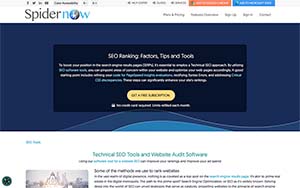Improve your search engine rankings
How you can begin to improve your SEO position and rankings

Improve rankings with SEO tools
This guide is meant for anyone who uses search to manage, legalize, or promote content on the Internet. This guide may be useful if you own a business or website, are an SEO professional, or are just interested in how search engines work. We will provide information that anyone who is interested in learning more about SEO can benefit from. In this manual, you will learn how to make your content easier to understand for search engines. SEO (or Search Engine Optimization) often involves making small changes to your website. It might not seem like these changes have much effect alone, but they can have a significant impact on user experience and organic search results. Despite being familiar with some of the topics we will cover, you might not be taking full advantage of them. When creating a website, creating the best user experience possible should be your top priority. A search engine can help users to find your sites, and SEO can help search engines better understand your content. While your online content may be smaller or larger compared to the average website, the information in this manual can apply to sites of any size.
Getting started with getting your site in the search engine's index?
To test whether your site is in the search engines, you can do this basic test: type site: [your site’s URL] into the SERPs. If your site shows up as one of the first results, then your site is on the search engines.
There may be a number of reasons why your site isn’t on search engines:
→ Your site has launched recently and it hasn’t gotten the chance to crawl it yet
→ When attempting to crawl your site, received an error
→ The site’s design makes it challenging for the search engines to crawl it
How do I get my site on the search engines?
The search engines uses web crawlers to constantly look for new sites to add. Most of the sites listed were added in automatically, not manually. If yours was not added automatically, no need to worry! It provides webmaster guidelines to build a website that can allow them to crawl your site. While it is not guaranteed that the search engines can crawl your site, following these steps can make it easier for your site to appear in their search results.In order to help you submit your site to the search engines, you can use the Search Console. With Search Console, you can turn on notifications that alert you of issues with your website that it finds.
Help the search engines find your content
In order for search engines to add your site to their index, and needs to know where it is. You can use a sitemap, which is a file that alerts search engines any time you update your website.
Tell search engines which pages you don't want crawled
For data not requiring special protection you can stop robots.txt from crawling your website. The file robots.txt, located in the root directory, can filter which pages of your site the search engines can access. However, it is possible that parts of your sites that are blocked can still be accessed and crawled. For more sensitive pages, a more secure method would be advised.
You should avoid allowing the search engines to crawl your internal search result pages. This can cause users to end up on a different search engine page than they clicked on.
For sensitive information, use more secure methods
For more sensitive pages, the robots.txt file may not be the best way to block search engines. While the file can tell crawlers that a page should not be accessed, it cannot stop browsers from receiving those pages. This could be because if there are links to the URLs you block in different places, search engines can still reference them. Another reason could be that if search engines don’t follow the Robots Exclusion Standard, it could deny the robots.txt. A final reason that the robots.txt file might not work could be that someone could guess the URL to your sensitive pages by studying your robots.txt file.
To prevent this, you can use the noindex tag. This is used when you don’t want the page to appear in the search engines. However, it can be accessed if someone has the URL. The best way to secure your pages would be to require authorization, like asking for a password.
Help the search engines (and users) see and understand your content
Normally, search engines can only see the page how the users see it when they crawl your pages. If you want the SERPs to crawl your page more effectively, you can allow them to access your JavaScript, image files, and CSS. However, if your robots.txt file does not allow the search engines to crawl these parts of your site, then you can’t render your consent as well as you could, which could affect your rankings.
You can use the URL Inspection tool if you want to see how the SERPs will see your site and can help you to find and fix any issues.
Create unique, accurate page titles
If you want to see what the topic of a specific page is, you can use the <title> element. You can create a title for each page if you put <title> inside of the <head> element of your HTML document.
Control your title links and snippets in search results
The <title> element could appear as the title of your link if your document is in a search results page. It can include bits of information such as the name of your website/business, your businesses main focuses, and the physical location.
Accurately describe the page's content
You should try to choose a title that can communicate what your business or website is about to the user.
Avoid: You should avoid using text that doesn’t relate to your content, or any default text such as 'Untitled Page'.
Create unique <title> elements for each page
A good idea to help the search engines to know how to distinguish each page would be to add unique text to the <title> element. You should also add different text on different versions of your site, such as a mobile version.
Avoid: You should not use the same title for a large portion of your pages.
Use brief, but descriptive <title> elements
You should also avoid making the titles too long, since search engines may show you only a small portion of the text.
Avoid: You should avoid using long text in the <title> elements
Use the meta description tag
The meta description tag is a tag that you give to a page that describes what the page’s purpose is. This tag can be longer than a title, and can even be a short paragraph. Similar to the title, it is placed in the <head> element. What are the merits of meta description tags? Tags are important because they might be used in the search results for your pages. This is not always the case, however, as the search engines could choose to use part of your page’s text instead. But using the meta description tags are always important since SERPs might not be able to use good text on your page as snippets.
Accurately summarize the page content
When writing your meta descriptions, you should write in an informative and interesting way. Even though there is no limit to the amount of characters you can write in the tag, it is better to write a short paragraph than a few words.
Avoid: When writing a meta description tag, you should try to use specific descriptions instead of generic sentences. You should also avoid only using keywords.
Use unique descriptions for each page:
The meta description tags are important to both search engines and users. However, if your websites have a large number of pages, typing a unique meta description may not be worth the time and effort. When this happens, generating these descriptions automatically might be a better option.
Use heading tags to emphasize important text
In order to organize your content in an easy to understand way, you should add meaningful headings.
Imagine you're writing an outline
You should decide where to write heading tags and where to write main and sub points.
Avoid: You should always add useful text in the headers and avoid using heading tags when other tags (such as <strong> and <em>) may be better fit.
Use headings sparingly across the page
You should use headings sparingly, since too many can make your content more cluttered for users.
Add structured data markup
To help search engines better understand your site's content, structured data can be added to your pages to describe your content. In search results, search engines can display your content in eye-catching and helpful ways based on this understanding. Your business can then attract the right kind of customers as a result.
Having an online store that marks up individual product pages makes it easier for us to realize that the page features a bike, its price, and customer reviews. This information may be displayed in the snippet for relevant search results. This type of results is known as rich results.
We may serve relevant results in other formats as well as using structured data markup for rich results. If you have a brick-and-mortar store, marking up your opening hours allows your potential customers to find you when they need you, despite your store being open/closed when they search. To describe your content, you should use structured data with any of the supported notations markup. You can use tools like Data Highlighter and Markup Helper to add the markup to your HTML code.
Check your markup using the Rich Results Test
Use the Rich Results test after you’ve marked up your content to ensure that there are no mistakes. Copy the HTML that includes the markup or enter the URL where the content is located.
Use Data Highlighter and Markup Helper
Data Highlighter, an integrated search console tool that supports a subset of content types, is a tool that lets you experiment with structured markup without having to change the html or the code of the web page. Try the Markup Helper if you want the markup code ready to copy and paste.
Avoid: If you are unsure how to implement markup, change the source code of your site.
Keep track of how your marked up pages are doing
Rich results reports in Search Console give you a breakdown of the number of pages on your site with a particular type of markup, how often they appear in search results, and how often they are clicked.
Manage your appearance in search results
Structured data is one of the most important components of a page in the search engines, because it can be used to achieve a variety of special results, as well as star reviews, enhanced results, and others. See the list of possible results in the gallery below.
Organize your site hierarchy
Understand how search engines use URLs
To crawl and index content, and to refer users to it, search engines need a unique URL for each piece of content. To be indexed properly in search, different content types and variations must have separate URLs.
If possible, search engine suggests using https:// for all your websites. It’s most commonly the same domain name as your email address. Search engines can distinguish between www.example-website.com and just example-website.com. You should add both the http:// and https:// versions of your website when adding it to Search Console.
The hostname and protocol are case-insensitive, so upper or lowercase won’t affect the URL. The path, filename, and query string determine what content from your server is accessed.
Due to the fact that fragments, such as #info, are used only to identify which part of the page the browser scrolls to. As there is usually no difference in content regardless of the fragment, search engines tend to ignore fragments.
There is no need to use a trailing slash after the hostname because both redirects to the same page. A trailing slash in a path or filename is seen as a different URL.
Navigation is important for search engines
Visitors can quickly find the content they want through the navigation of a website, while search engines can learn what the website owner thinks is important by the navigation of a website. In addition to providing search results by page, it likes to understand the bigger picture that a page contributes to.
Plan your navigation based on your homepage
For many visitors, the home or root page of a website is the starting place for navigation and usually the most frequently visited page. Make sure you consider how visitors will access pages containing more specific information, unless your site has only a few pages.
Using breadcrumb lists
Breadcrumbs allow visitors to navigate back to a previous section or the root page quickly through a row of internal links on a page. When showing breadcrumbs, it is recommended to use breadcrumb structured data markup when displaying the most general page.
Create a simple navigational page for users
You can display the structure of your website on your navigational page, which usually contains a hierarchical listing of your site’s pages. It's main purpose is to attract human visitors to your site, but search engines will also crawl this page.
Create a naturally flowing hierarchy
Use navigation pages effectively and work them into your internal link structure when it makes sense for users to go from general to more specific content. To enable users to discover similar content, link to related pages on your site, where appropriate. Make sure all of the pages on your site can be reached through links.
Use text for navigation
It is easier for search engines to crawl and understand your site if most of the navigation between pages is controlled by text links. Rather than waiting for the user to interact with the page, use a JavaScript element with URLs as href attribute values, and generate all menu items on page-load, instead of waiting for a user interaction.
Create a navigational page for users, a sitemap for search engines
Provide users with a simple menu system for your entire site so that they can navigate quickly. An XML sitemap file, which lists all relevant URLs along with their last modified dates, will help search engines discover new and updated pages on your site.
Show useful 404 pages
A 404 page kindly guides visitors back to a working page on your site if they arrive at an incorrect URL or follow a broken link on your site. Users can utilize search engines Console to discover the "not found" issues found on your website. Include a link to your root page and links to your most popular or related content.
Avoid: You should avoid allowing search engines to index your 404 pages.
Simple URLs convey content information
By categorizing and naming your website’s documents in a descriptive manner, you will not only keep your website more organized and make linking to it easier. URLs with few recognizable words that are extremely long and cryptic may intimidate visitors.
URLs are displayed in search results
As a final note, the URL to a document will usually appear near the document title in a search engine result. Even complex URL structures are crawled by the search engines, but it’s good practice to keep URLs as simple as possible.
Use words in URLs
Visitors navigate your site more efficiently if your URLs contain words that relate to the content and structure of your site.
Create a simple directory structure
You can use your directory structure to indicate the type of content found at that URL. If you know what type of content is found at that URL, you can use your directory structure to indicate it.
Provide one version of a URL to reach a document
Focus on using and referring to one URL in your structure and internal linking to prevent users from linking to different versions of a URL. You can fix this by setting up 301 redirects from non-preferred URLs to the dominant URL if people are accessing the same content from multiple URLs. The rel='canonical' link elements can also be if you can’t redirect.
Optimize your content
Make your site interesting and useful
You should focus more on creating engaging and useful content on your website than on any other factor. Good content will likely be shared by users who see it, and other users will likely appreciate it as well. You may do this through blog posts, social media services, email, forums, or some other method.
Quality content helps your site’s reputation both with users and the search engines, and organic or word-of-mouth publicity helps.
Know what your readers want (and give it to them)
Take a moment to consider the words that a user might type into a search engine to find your content. It is possible that people who are knowledgeable about the topic use different search terms in their searches than those who are not. While writing your content, you should anticipate and account for these differences in search behavior. There is an easy-to-use Keyword Planner feature offered by ads that helps you discover new keyword variations and see how many searches each keyword receives. Performance Reports provided by Search Console shows you your site’s top search queries and those which have referred the most traffic to it.
You might want to consider creating a new, valuable service not offered by any other site. Your unique user base could also be leveraged to write an original piece of research, break an exciting story, or write an original piece of news. It may be difficult for other sites to provide these services due to a lack of resources or expertise.
Write easy-to-read text
Content that is easy to understand and well written is more likely to be viewed by users.
Organize your topics clearly
Organizing your content so that visitors can differentiate between content topics is always beneficial. Users can find the content they want faster when your content is divided up into logical chunks or divisions.
Create fresh, unique content
The addition of new content will not only keep your existing visitors returning, but will also bring in new ones.
Optimize content for your users, not search engines
A well-designed and easily accessible site that caters to the need of visitors usually yields positive results.
Act in a way that cultivates user trust
Let users feel comfortable visiting your site if they feel that it's trustworthy. Develop a reputation as an expert and trustworthy site in a particular field of expertise. Your website should include information about who publishes it, who provides the content, and what the site aims to achieve. You should provide clear and satisfactory customer service information if you operate a shopping or other financial transaction website. It is important to make it clear who is responsible for the content if you own a news site.
In addition, using the right technology is crucial. Users can’t trust a site that doesn’t have a secure connection in a shopping checkout page for instance.
Make expertise and authoritativeness clear
The quality of a site is increased when it is authoritative and expert. You should have people who are experts in the top creating or editing content for your website. Users can gain a deeper understanding of the expertise of articles by providing expert or experienced sources. When such consensus exists, it is good practice to present it in pages on scientific topics.
Provide an appropriate amount of content for your subject
Time, effort, expertise, and talent/skill are all essential to the creation of high-quality content. The content should be accurate, concise, and clearly written.
Avoid distracting advertisements
Despite the fact that we expect to see advertisements on the site, don’t let them distract users or prevent them from engaging with the content.
Avoid: You should avoid adding advertisements that distract from your page.
Use links wisely
Users and search engines can use link text (the text in a link that you can see) to learn more about the page you are linking to, as well as the text contained within the link itself. A link can be either external or internal. Internal links are those that point to pages on your website, while external links will lead to content on another website. It is always better to make your anchor text as good as you can so that users can learn what your page is about and helps users to find your site easier.
Choose descriptive text
When creating anchor text, it should provide the user with a basic understanding of the purpose behind your site.
Write concise text:
You should avoid writing long text and instead opt for using short text that can describe your site well.
Think about anchor text for internal links too
Linking to outside websites is usually thought of as pointing to other sites, but anchor text can improve your site's ability to be navigated better by search engines and users.
Be careful who you link to
Whenever your site links to another site, you can share some of the reputation your site has built up. In comment sections or message boards, users can add links to their own websites. There are times when you do not want to credit a site with your reputation because you mention it in a negative light.
A widget link is another example of how the nofollow attribute can be useful. When you use a widget from a third party to enhance your site and engage users, make sure the widget doesn’t contain any links you didn’t intend to place on your site. Make sure you are not placing any links on your site that you did not intend to have alongside the widget if you are using a third party’s widget to enhance the experience. As a website owner, you may not have control over anchor text in widgets that add links to your site. There is always a way to disable such links with nofollow if you can’t remove them from the widget. You should include the nofollow on links in the default code snippet if you are creating a widget for functionality or content you provide.
You can also nofollow every link on a page by adding a meta tag inside its head tag (<meta name=' robots' content='nofollow'>).
Combat comment spam with nofollow
When linking to another page, set the rel attribute to nofollow or urgc to not follow the link’s reputation. This could be useful if you have a blog with public comments enabled, as links within those comments may pass your reputation to pages on your site that you aren’t comfortable recommending. It is common for comment spam to appear in blog comment areas on pages. When you nofollow these links, you won’t give your site’s reputation to spammers.

Bryan Williamson
Web Developer & Digital Marketer

Web Developer & Digital Marketer
Digital Marketer and Web Developer focusing on Technical SEO and Website Audits. I spent the past 26 years of my life improving my skillset primarily in Organic SEO and enjoy coming up with new innovative ideas for the industry.













